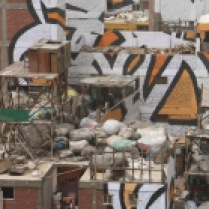Early each morning, we open the front door and place a plastic bag containing the previous day’s trash next to the welcome mat of our 5th floor apartment. And every morning it is gone by the time I leave for work at 7:10. Where does it go?
Cairo has an unusual but effective system for household waste management. Men called “zabbaleen” – literally, “garbage people” – collect garbage door to door every morning within established, often inherited, territories. They bring the haul (over 10,000 tons of it every day) back to their homes in Monshiyat Naser (“Garbage City”) at the foothills of the Muqattam mountains on the edge of Cairo.
Family members sort the garbage into 16 different types. A whopping 85% of it is reused or recycled: plastic is sorted and reformed into flower pots and coat hangers, paper is sold to a recycling plants, organics are fed to livestock. The zabbaleen make their living from tips given by residents in their territories combined with income from the sale of the trash they collect.
Although the zabbaleen perform an essential service for this city of 18 million people, historically they have been poorly regarded and ill treated. The people who became the zabbaleen were originally farmers from Upper Egypt who migrated to Cairo during a drought in the 1940s. Almost all of them are Coptic Christians who built their their livelihood around the business of collecting organic garbage to feed to the pigs that they raised. The zabbaleen have always been outsiders in the city. A few years ago the government sought to do away with the traditional system by bringing in foreign companies to take over and modernize trash collection. The plan was a massive failure, and the government asked the zabbaleen to return to the job they have done so well for the past 70 years.
Last weekend Andreas and I visited Garbage City for the second time (the first time was with Alekka, Nik, and Kosta in December; this time we went with a group of AISWest teachers). Both times we started our visit with a tour of the Association for the Protection of the Environment, a non-profit that teaches crafting skills to women, who earn income through the sale of their rugs, stationery, and jewelry.
We also visited the Children’s Club preschool, which has a special relationship with AIS West. The kids are adorable and all want their picture taken.
Notice the small cross tattoos on the wrists of these little guys. Christians in Egypt typically wear these tattoos as a mark of their faith.
Then we take a walk through the streets. This part is most fascinating to me as we get to see the garbage recycling systems in action. We try hard not to get in the way of people doing their jobs in the narrow streets, but there is no hope of us blending in.
The buildings are tall and the streets are narrow. The ground floors are occupied by sorting stations and workspaces, while the residents (some 50,000 or more) live above. The people we meet are friendly and welcoming – it helps that our guide is a resident – if a bit bemused by their status as tourist attraction. Homes, streets, and businesses are decorated with Christian symbols and interesting items that Cairenes have thrown away.
We finish our tour with a visit to the Coptic cave churches just outside the city gates.
On our outing two weeks ago we enjoyed a special treat: a view of the new mural created by the artist eL Seed. It is painted in parts onto the the walls of more than 50 buildings. The government does not get involved with the doings in this part of the city, and when eL Seed obtained the blessing of the local priest, the residents were happy to participate. We climbed up into the unfinished top floor of a building across from the amphitheater to get the correct angle.
The title of the work is “Perception,” and the artist calls it a “calligrafitti”. The Arabic lettering quotes a Coptic bishop who said, “if one wants to see the light of the sun, he must wipe his eyes.”
For a description of the life of a Cairo trash collector, I recommend this article by Peter Hessler in the New Yorker. The subject of this piece is Muslim, though, which is atypical; an estimated 95% of zabbaleen are Copts.







Thank you so much for sharing this! love what El-seed has done. 🙂 I am writing a report about garbage city and would like to ask you what challenges are currently faced by the people in Garbage City – other than not having a stable income?